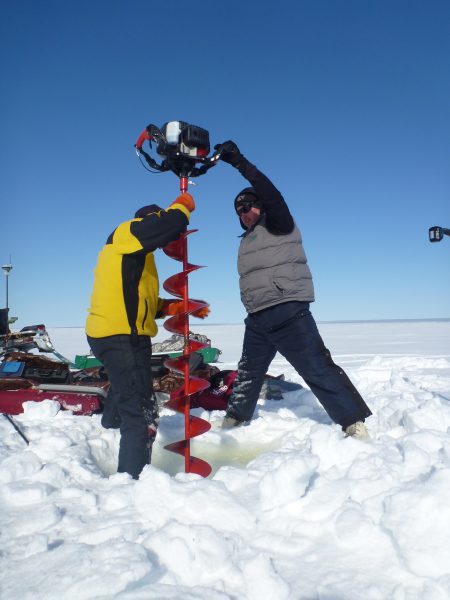Permafrost thawing below shallow Arctic lakes
June 16, 2016
Sue Mitchell
907-474-5823

New research conducted by scientists at the University of Alaska Fairbanks, the U.S. Geological Survey, the University of Wyoming and other institutes shows that permafrost below shallow Arctic lakes is thawing as a result of changing winter climate.
Warmer winters, combined with an increase in snowfall during the last 30 years, have limited the growth of seasonal lake ice. In response, lake bed temperatures of Arctic lakes less than a meter deep have warmed by 2.4 degrees Celsius during the past three decades, and during five of the last seven years, the mean annual lake bed temperature has been above freezing.
These rates of warming are similar to those observed in terrestrial permafrost, yet those soils are still well below freezing and thaw is not expected for at least another 70 years. However, a regime shift in lake ice is leading to sub-lake permafrost thaw now.
Since permafrost underneath lakes is generally warmer than the surrounding terrestrial permafrost, rising temperatures in the lake beds make permafrost thaw sooner than beneath surrounding dry land. These lakes may cover 20 to 40 percent of the landscape in vast areas of Arctic lowlands.
Christopher Arp, research assistant professor at UAF’s Water and Environmental Research Center, is the first author on a paper published this week in Geophysical Research Letters. “During the 1970s, late winter lake ice thickness measurements commonly exceeded 2 meters (6.5 feet) in northern Alaska. Such thick ice growth helps to limit sublake permafrost thaw by freezing the sediments solid each winter. However, during winter field surveys over the last decade, lake ice has typically only grown to 1.5 meters (5 feet) thick, and has been as thin as 1.2 meters (4 feet),” Arp said.
These drastic reductions in lake ice, caused by changes in winter climate, are the primary reason that shallow lake bed temperatures are warming and the permafrost below them is thawing.
Interactions and feedbacks among climate, permafrost and hydrology underscore the complexity of forecasting change in the Arctic. For example, thinner lake ice may help overwintering fish, or it may help the oil industry, which uses lake water to build winter ice roads. However, sublake permafrost thaw will likely unlock a portion of the permafrost carbon pool and potentially release this carbon in the form of greenhouse gases.
These findings also highlight the importance of conducting winter fieldwork in the Arctic. Benjamin Jones, with the U.S. Geological Survey in Anchorage, said, “Arctic lakes and ponds are typically ice-covered for nine months of the year, but research on them typically occurs during the short Arctic summer. To more fully understand Arctic lake dynamics and to document the changes we have observed requires also doing fieldwork under often harsh conditions during the cold and dark Arctic winter.”
Vladimir Romanovsky of the UAF Geophysical Institute, another author on the paper, added, “With further thawing of sublake permafrost there is a good chance that the ground will subside, increasing the lake depth and accelerating further permafrost thawing. In contrast, the warming on the land may increase the protective vegetation layer and delay thawing of permafrost outside of lakes.”
With increasingly warmer and snowier winters yielding thinner lake ice, shallow lakes will likely continue to warm, said Arp.
FOR MORE INFORMATION: Christopher Arp, 907-474-2783, cdarp@alaska.edu; Vladimir Romanovsky, 907 474 7459, veromanovsky@alaska.edu; Benjamin Jones, 907-786-7033, bjones@usgs.gov
NOTE TO EDITORS: More photos available. Contact Sue Mitchell, 907-474-5823, sue.mitchell@alaska.edu


